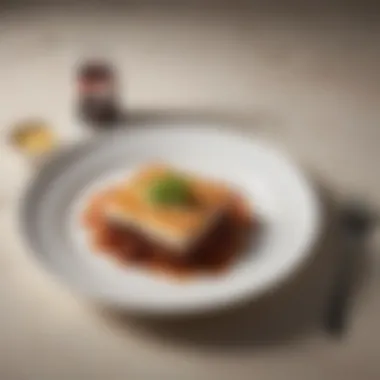Top Microwave-Safe Dinner Plates for Easy Meals


Intro
When it comes to utilizing a microwave for meal preparation, the choice of dinner plates plays a crucial role. Not all plates are created equal; some materials perform better under high temperatures while others may pose safety risks. This comprehensive guide focuses on the best dinner plates designed specifically for microwave use.
Understanding the intricacies of materials such as glass, ceramic, and plastic can elevate your dining experience. Each type offers distinct advantages, which we will explore in detail.
Additionally, knowing the safety features and designs to look for can help you make informed decisions when selecting dinnerware. The sections ahead will decode the characteristics that define the best microwave-safe plates, along with recommendations based on extensive research and consumer ratings.
Preamble to Microwave-Safe Dinnerware
In today’s fast-paced world, microwave cooking has become a common practice, making microwave-safe dinnerware an essential aspect of our kitchens. Understanding the significance of this dinnerware is crucial for maintaining both safety and food quality while utilizing microwave ovens. Selecting the appropriate plates can enhance cooking experiences and provide convenience in meal preparation.
Microwave-safe dinner plates are specifically designed to withstand the heat generated by microwave radiation. This quality prevents plates from warping, cracking, or releasing harmful substances, all of which can compromise health and affect the taste of the food. For those who frequently reheat leftovers or cook meals in the microwave, knowing which materials and designs are safe is paramount.
Choosing the right dinnerware not only ensures safety but also impacts whic appliance related experience you will have. The wrong materials can lead to uneven heating, resulting in cold spots in food and potential safety hazards. Hence, exploration into various types of materials, such as ceramic, glass, and plastic, is vital. By understanding the differences and advantages of each, consumers can make informed decisions that meet their needs.
"Choosing the right dinnerware can enhance meal preparation and ensure safe use of microwave ovens."
By understanding the advantages of microwave-safe plates, users can avoid common pitfalls associated with microwave cooking. The following section will delve into understanding how microwaves operate and why certain materials are preferable for cooking.
Understanding Microwave Use
Microwave ovens work by emitting electromagnetic radiation, which is absorbed by the food. This process generates heat, cooking the food from the inside out. Unlike conventional ovens, microwaves heat food differently, necessitating that the dinnerware used is capable of withstanding specific radiation effects. It is important to be aware that not all materials are suitable for this purpose.
Thus, there are two primary considerations when selecting microwave-safe dinnerware. First, a plate should not be made of metal as this can cause arcing and subsequently damage both the dinnerware and the microwave oven. Second, the materials should be designed to endure high temperatures without altering the food's safety or quality.
Common materials seen in microwave-safe plates include:
- Ceramics: Known for good heat retention and even cooking, ceramic materials must be checked for safety prior to use in microwaves.
- Glass: Typically safe and non-reactive, glass dinner plates can handle heat well but may risk breakage if subjected to rapid temperature shifts.
- Plastic: While often less expensive, it's imperative to check labels for BPA-free status and ensure that plastics are designated for microwave use.
- Melamine: Often used due to its durable nature; however, it may not always be microwave-safe, needing specific labeling.
The information presented here sets the stage for understanding the importance of microwave-safe dinnerware. These considerations not only enhance safety during microwave use but also support the quality of meals prepared. Knowing which features to look for will ease the decision-making process when selecting dinner plates for everyday use.
Importance of Choosing the Right Dinner Plate
Choosing the right dinner plate for microwave use is essential for both safety and the overall dining experience. It may seem trivial, but the dinnerware used can affect not just the sustenance served, but also how it retains flavors and maintains textures. Selecting appropriate plates ensures that meals can be reheated without negative repercussions.
The significance of this choice stems primarily from safety considerations. Plates that are not designed for microwave use can warp or leach harmful chemicals into food. This aspect of material science is critical; safe materials prevent health risks and enhance peace of mind during meal preparation. Moreover, using microwave-safe plates can result in a more efficient reheating process, saving time and energy.
Additionally, the influence on food quality can not be overlooked. A dinner plate that can handle direct heat can maintain the ideal temperature of the food, preserving its taste and texture. For instance, using a ceramic plate promotes even heating, reducing cold spots that can lead to unpalatable meals.
In summary, selecting the right dinner plates is more than a matter of aesthetics; it affects health, efficiency, and food experience. Everyone deserves a dining experience that is both safe and enjoyable.


Materials Used in Microwave-Safe Dinner Plates
Understanding the materials that compose microwave-safe dinner plates is essential. The choice of material affects not only the safety of the plates but also their functionality and usability in the kitchen. Different materials have unique properties that can influence how they interact with microwave energy, as well as how they handle food temperature. Knowing these factors can guide your decision when selecting dinnerware for everyday use.
Ceramic Plates
Ceramic plates have long been favored for their aesthetic qualities and durability. They are generally safe for microwave use, provided they do not have metallic decorations. The benefits of using ceramic include their ability to withstand high temperatures and their relative ease of cleaning. These plates can also retain heat well, which means they keep food warm for a longer duration after microwaving.
However, there are some considerations to keep in mind. Ceramic can be prone to thermal shock if subjected to sudden temperature changes. This means it is advisable to let the plates cool down gradually rather than placing a hot plate in cold water. Always check for the manufacturer's guidelines to ensure the ceramic plates are labeled microwave-safe.
Glass Plates
Glass plates are another excellent option for microwave-use. They are non-porous and do not absorb food odors or flavors, making them a hygienic choice. Glass dishes can also endure high heat, making them perfect for reheating a variety of dishes. This material allows for even heating, which is important when ensuring that food is warmed thoroughly throughout.
Nevertheless, caution should be exercised regarding thermal shock, much like with ceramic plates. Switching from extreme cold to extreme heat can cause glass to crack or shatter. As a rule of thumb, check if the glass is specifically marked for microwave use. Some glass types, like tempered glass, can handle these temperature shifts better.
Plastic Plates
Plastic plates are popular for their affordability and lightweight nature. When selecting plastic for microwave use, it's critical to look for BPA-free options specifically labeled as microwave-safe. Some plastics can warp or leach chemicals when exposed to high heat, potentially affecting food quality and safety.
The convenience of plastic is notable as they are often dishwasher safe, making cleanup easy. However, one must avoid using plastic containers that are not designed for microwaving, as they could release harmful substances into the food. Additionally, ensure the plates are not overly scratched or worn, as damaged surfaces can harbor bacteria.
Melamine Plates
Melamine plates, while not traditional dinnerware, offer a range of advantages. They can mimic the look of ceramic while being more lightweight and durable. However, it's important to note that melamine is generally not considered microwave-safe. It can warp or leach chemicals when heated, which poses health risks.
Despite these drawbacks, melamine's resilience and ability to withstand drops make it popular for casual dining. They are preferred mainly for non-microwave-related applications such as outdoor gatherings. If considering melamine plates, it is prudent to limit their use to non-heated situations.
Features to Look for in Microwave-Safe Plates
When selecting dinner plates specifically designed for microwave use, several features play crucial roles in ensuring safety, functionality, and style. These elements are not just a matter of preference; they significantly influence the cooking process and overall dining experience. Understanding them can help consumers make informed decisions that elevate their everyday meals.
Heat Resistance
Heat resistance is among the most vital aspects of microwave-safe plates. As food is heated in the microwave, it generates steam and extreme temperatures. Dinnerware must withstand these conditions without warping or cracking. Plates made from materials such as high-fired ceramics and certain types of glass tend to excel in this regard. They possess the capability to distribute heat evenly, reducing the risk of hotspots that can lead to burns or further damage to the plates.
Choosing plates with high heat resistance means you can enjoy your meals without the fear of broken dishes or unwanted reactions.
Dishwasher Compatibility
Another important factor is the compatibility of these plates with dishwashers. A dishwasher-safe plate allows for convenient and easy cleanup after meals. Materials like tempered glass and certain types of ceramics are typically safe for dishwasher use, making them more practical for those with busy lifestyles. Checking labels for these specifications can save time and effort.


Using dishwasher-compatible dinnerware ensures that you can maintain cleanliness without the labor of hand-washing, giving more time for enjoyment and less for chores.
Design and Aesthetic Appeal
Lastly, the visual aspect should not be overlooked. Design and aesthetic appeal play significant roles in setting the dining atmosphere. Microwave-safe plates come in various colors, patterns, and shapes. Choosing dishes that complement your dining decor can enhance the meal presentation. A well-designed plate can elevate the appearance of even the simplest dishes, making meals feel special and inviting.
Considering aesthetics alongside functionality will lead not only to a warm meal but also to a pleasing dining experience.
"Practicality and style can coexist in microwave-safe dinnerware, merging usefulness with visual appeal."
Top Dinner Plate Options for Microwave Use
When considering dinner plates for microwave use, it is crucial to focus on options that not only withstand the rigors of a microwave environment but also enhance the overall dining experience. This section delves into why the right choice of dinner plates can impact functionality and style during meal preparations. Ceramic, glass, and plastic plates each bring their own advantages and address specific needs. Evaluating these options will help consumers make informed decisions based on safety, usability, and aesthetics.
Best Ceramic Options
Ceramic plates are often celebrated for their heat retention and aesthetic qualities. They tend to be durable and can handle a variety of foods, providing an even heating experience in the microwave. When selecting ceramic options, it is important to look for plates that are specifically labeled as microwave-safe. This information indicates that the ceramics will not crack or break due to thermal shock.
Many ceramic plates come with vibrant designs or glazes, adding an appealing visual element to dining. However, one must be cautious about the potential inclusion of lead or cadmium in glazes. Always verify that the ceramic dinnerware meets safety standards.
Top Glass Dinner Plates
Glass dinner plates offer a unique advantage in that they are typically more resistant to stains and odors compared to other materials. Many glass options are also microwave-safe, making them convenient for reheating. However, thermal shock is a concern; thus, it is crucial to choose tempered glass, which is designed to withstand the rapid temperature changes that occur in microwaves.
When shopping for glass dinner plates, look for products free of harmful chemicals such as BPA. Additionally, consider the transparency of the glass, as clear glass allows for better monitoring of heating processes.
Recommended Plastic Plates
Plastic plates are lightweight and can be more affordable than their ceramic or glass counterparts. However, it is vital to choose high-quality plastic that is specifically designed for microwave use. Not all plastics can withstand microwave heating safely. The best options for microwave-safe plastic dinner plates include those made with polypropylene, which is durable and resistant to heat.
One significant concern when using plastic plates is the potential for chemical leaching, especially when heating fatty or acidic foods. Therefore, look for labels indicating that the plastics are BPA-free and designed for microwave interaction. Practicality and ease of cleaning are additional benefits when selecting plastic dinnerware, but caution is needed in their use.
Potential Concerns with Microwave Dinner Plates
When selecting dinner plates for microwave use, understanding the potential concerns is crucial. This ensures not only the safety of the food being consumed but also the longevity and appropriateness of the dinnerware itself. While many products are marketed as microwave-safe, factors such as material composition and user habits can impact the overall experience. It is therefore imperative to scrutinize these concerns before making a purchase.
Chemical Leaching in Plastics
Plastic plates are popular due to their lightweight nature and affordability. However, a significant concern with using plastic dinnerware in microwaves is the potential for chemical leaching. Chemical leaching occurs when heat causes certain substances in plastics to migrate into food or beverages. Some plastics, particularly those not labeled as BPA-free, can release harmful chemicals when heated.
Choosing plates marked as microwave-safe provides a layer of reassurance. This labeling often means they have undergone rigorous testing to assess safety standards. However, not all manufacturers adhere to the same guidelines, so it is wise to research specific brands further. Despite advancements in plastic manufacturing, awareness of the risks of chemical leaching must guide consumer choices.


Key points to be aware of include:
- Look for BPA-free labels to minimize exposure.
- Avoid using damaged or old plastic plates, as wear can increase leaching risk.
- Consider alternatives like glass or ceramic for high-heat meals.
"Investing in quality mealware can safeguard both health and taste."
Thermal Shock with Glass
Glass plates offer elegance and durability, making them a popular choice. However, a notable risk with glass dinnerware in microwaves is thermal shock. This phenomenon occurs when glass experiences sudden temperature changes, leading to its cracking or shattering. For example, placing a cold glass plate directly into a hot microwave can create uneven heating. This contrast in temperature can cause stress within the glass, prompting fractures.
To mitigate the risks associated with thermal shock, consider the following recommendations:
- Allow glass plates to reach room temperature before microwaving.
- Use microwave-safe glass dishes designed specifically to withstand high temperatures.
- Avoid sudden temperature changes during cooking.
Care and Maintenance of Microwave-Safe Dinner Plates
When it comes to using microwave-safe dinner plates, understanding the care and maintenance is very important. Proper handling and storage can significantly extend the life of these dishes. Microwave-safe dinnerware may withstand heat and temperature changes, yet they require diligence regarding cleaning and storage. Failure to properly maintain these plates can lead to diminished performance and reduced lifespan, ultimately affecting your dining experience.
Cleaning Recommendations
To ensure your microwave-safe plates remain in optimal condition, follow these cleaning guidelines:
- Gentle Wash: Use mild detergent and a soft sponge to clean the plates. Avoid abrasive cleaning pads as they may scratch the surface.
- Avoid High Temperatures: Do not expose these plates to extreme temperature changes while cleaning. Sudden changes can lead to thermal shock.
- Dishwasher Use: Check if the plates are dishwasher-safe. Many ceramic and glass plates can go in both top and bottom racks, but plastic may warp under heat.
- Stain Treatment: For tough stains, soaking the plates in warm, soapy water for a short time can loosen grime. In many cases, a paste made of baking soda and water can effectively lift stubborn marks.
- Drying: Air drying is preferred. If using a towel, ensure it is clean and soft to avoid any residue left on the plates.
Implementing these steps can keep your dinnerware looking new and performing well. Avoid harsh scrubbing or chemicals that may degrade the materials over time.
Storage Tips
How you store your microwave-safe dinner plates also plays a role in their longevity. Consider the following tips for effective storage:
- Stacking with Care: If you stack plates, use protective padding between them. Cloth or paper towels work well to prevent scratches.
- Avoid Overcrowding: Ensure plates are not crammed together. This reduces the risk of chips and cracks.
- Dry Before Storing: Always ensure that plates are completely dry before placing them back in the cabinet. Moisture can lead to mold, especially with wooden or plastic storage solutions.
- Temperature Control: Store in a climate-controlled area. Extreme heat or cold can find its way to the materials, potentially leading to long-term damage.
- Accessibility: Place frequently used plates in an easily accessible area. This reduces the risk of accidents that may occur when reaching for dishware that is piled high.
By following these cleaning and storage recommendations, your microwave-safe dinner plates can remain functional and visually appealing for many meals to come.
Culmination
Key Considerations
When choosing dinner plates for microwave use, remember to focus on material types, heat resistance, and susceptibility to thermal shock. Selecting materials like ceramic or glass can enhance food presentation, while ensuring microwave safety. Always prioritize products that come with clear labeling, indicating their microwave-safe status.
Benefits of Appropriate Choices
The right dinner plate not only enhances your food's appeal but also minimizes food waste by allowing thorough heating. In addition, plates that are easy to clean and maintain will contribute to a more enjoyable cooking and dining experience. Overall, choosing dinnerware that aligns with both safety considerations and your lifestyle preference is fundamental.
"Quality dinnerware can transform mundane meals into delightful experiences."
Summary of Features to Evaluate
- Material: Look for ceramic, glass, or specific plastics designed for microwaving.
- Design and Aesthetics: Choose plates that compliment your kitchen and dining ambiance.
- Cleaning Ease: Ensure compatibility with dishwashers for hassle-free maintenance.
By applying the insights shared in this article, you will be better equipped to select plates that not only meet safety standards but also elevate your everyday dining. Taking the time to assess your options will undoubtedly lead to a more satisfying culinary journey.















